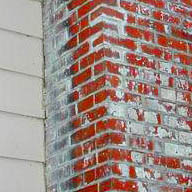What is that White Stuff on My Chimney?
White Stuff on Your Chimney is called Efflorescence
by Dave Lamb – dave@mychimneys.com
 You may think it is just something that happens to all chimneys as they age, but this white residue is actually an indication of a serious problem with the chimney. So many chimneys have this condition called “Efflorescence”, homeowners don’t pay much attention to it. Far from being only a visual eyesore, the condition is actually showing that the chimney is allowing water through the masonry which will cause structural deterioration and other problems.
You may think it is just something that happens to all chimneys as they age, but this white residue is actually an indication of a serious problem with the chimney. So many chimneys have this condition called “Efflorescence”, homeowners don’t pay much attention to it. Far from being only a visual eyesore, the condition is actually showing that the chimney is allowing water through the masonry which will cause structural deterioration and other problems.
Defining Efflorescence
 Efflorescence is a white crystallized or powdery substance found on stone, block, or brick masonry. The substance forms as a result of excess water in the structure that has evaporated and left behind salt deposits that take on a fluffy or fuzzy form and coat the exterior of the stone over time.
Efflorescence is a white crystallized or powdery substance found on stone, block, or brick masonry. The substance forms as a result of excess water in the structure that has evaporated and left behind salt deposits that take on a fluffy or fuzzy form and coat the exterior of the stone over time.
While the salt deposits themselves are mostly an aesthetic problem and will not cause structural damage, they are a tell tale sign of excess water and leakage present within the structure. The efflorescence is formed when the chimney structure cracks, has not been properly sealed or is missing a cap or other sealant. This allows rain water to seep into the brick or stone walls. As water moves through the wall, it dissolves salt particles naturally present in the masonry along the way. The water will then evaporate through the outside wall and leave behind the salt residue on the surface. These salt deposits create the white stain on chimneys. The visible salt residue is a sure sign of water leaking into the stone structure and if left alone, can cause serious damage to the structure. While the white salt on the surface is relatively easy to remove compared to other stains, further investigation must be done to stop the water leak at the origin and prevent structural damage.
The Conditions Needed for Efflorescence to Exist
Efflorescence cannot take place without the following 3 conditions.
1. There must be soluble-salts within the masonry structure.
2. There must be moisture to mix with the salts and create a soluble-solution.
3. The salt must be able to move through the masonry and evaporate on the other side leaving behind the crystallized efflorescence.
What Should Be Done About Efflorescence?

When efflorescence is visible from the outside, it likely continues into your attic also. This spreads moisture and creates mold and rot around the wood structural elements in the roof.
A Chimney Professional or Chimney Sweep should perform a Chimney Inspection that will detail the exact condition of the chimney system and the direct cause of the staining. They will recommend a course of action based on the extent of damage and deterioration present inside and outside of your chimney.
It is difficult to guarantee efflorescence will not later develop when building a chimney, but there are ways to lessen the chances of its occurrence. But by taking away any one of the 3 conditions listed above, efflorescence will not take place. The best way to reduce the appearance of efflorescence is to use materials in the building process that do not contain large amounts of soluble salts. These materials will contain low alkali. High alkali is known to contain more efflorescing salts. Proper drainage away from the structure will also serve to prevent efflorescence from occurring. Eliminating the moisture source will not allow the soluble-solution to form in the first place. Otherwise, brick sealants in the building process and before efflorescence has begun will prevent the deposits as well.
Associated Problems
Although it is sometimes mistaken for it, efflorescence is not mold. The wet conditions associated with efflorescence mean that the ideal climate for mold and other moisture related problems are present. Therefore, mold is commonly found along with efflorescence on the interior of the structure. Along with the removal of the white composites left behind from the efflorescence, the building should also be inspected for problem mold, allergens, and bacteria. Surfaces that contain organic material should be closely examined, such as wood, painted surfaces, carpet, insulation and padding.
Often outdoor efflorescence will disappear on its own with normal weathering and indoor deposits are relatively easy to wash off, but the problem will continue to reappear if the leak is not fixed at the source. The crack or missing part that let the water into the structure must be found and if there is not a place like this, the brick must be sealed. Brick is similar to a sponge; it does not act as a barrier against moisture.
 To find the cause of the efflorescence, begin at the top of the chimney working your way down while looking for missing mortar, cracks, missing caps, bad flashing and anything else that looks in need of repair. If there are no obvious problems, then the excess moisture is most likely seeping in through the brick and the brick will then have to be sealed once the current efflorescence has been removed. Sealing alone is not always a solution and at best it is a temporary fix. Many times chimneys may need structural repair or replacement to stop the damage to the home.
To find the cause of the efflorescence, begin at the top of the chimney working your way down while looking for missing mortar, cracks, missing caps, bad flashing and anything else that looks in need of repair. If there are no obvious problems, then the excess moisture is most likely seeping in through the brick and the brick will then have to be sealed once the current efflorescence has been removed. Sealing alone is not always a solution and at best it is a temporary fix. Many times chimneys may need structural repair or replacement to stop the damage to the home.
Different types of Efflorescence
 While efflorescence is most commonly seen in the white powdery form, it can also cause brown or yellow discoloration as well. The color of the stains depends on the types of salt found within the structure wall. Efflorescence producing salts typically come from sulfates of sodium, potassium, calcium, magnesium and sometimes iron. Crystalline deposits from over twenty different compounds have been found on masonry walls. The various colors come from different minerals. For example, molybdenum, magnesium compounds, and vanadium sometimes create a greenish colored stain. Manganese compounds can also create a brownish stain at times.
While efflorescence is most commonly seen in the white powdery form, it can also cause brown or yellow discoloration as well. The color of the stains depends on the types of salt found within the structure wall. Efflorescence producing salts typically come from sulfates of sodium, potassium, calcium, magnesium and sometimes iron. Crystalline deposits from over twenty different compounds have been found on masonry walls. The various colors come from different minerals. For example, molybdenum, magnesium compounds, and vanadium sometimes create a greenish colored stain. Manganese compounds can also create a brownish stain at times.
How to Remove Efflorescence from your Chimney
Much of the unsightly white efflorescence on the chimney will be washed away by rain and weathering. For tough stains, there are also cleaning products available that contain muriatic acid (very harsh chemical) for the do-it-yourselfers. Several DIY websites provide simple step by step instructions to mix your own cleaning solutions as well.
Any chimney that has efflorescence should be inspected by a professional chimney sweep to determine the extent of damage that the moisture has caused. If damage is minimal, they can remove the stains prior to sealing the chimney with a waterproofing product to slow down the leaking problem. Just remember that the while cleaning will remove the white deposits temporarily, the efflorescence will return and more water damage will continue occurring if the underlying problem is not found and repaired.


